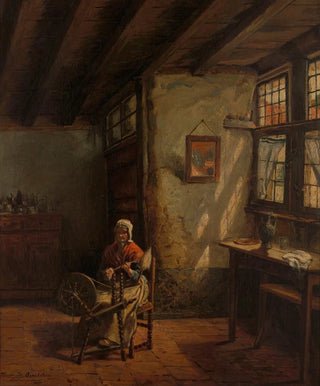Art print | The weaver - Henri de Braekeleer


View from behind

Frame (optional)
Henri de Braekeleer’s "The Spinner" artwork stands out as an iconic masterpiece of 19th-century Belgian painting. This canvas, depicting a serene domestic scene, invites viewers to immerse themselves in an intimate and everyday universe. Through the attentive gaze of the spinner, the artist captures the very essence of rural life, revealing a simple yet poignant beauty. The soft light bathing the scene, along with the meticulous details of textures, testify to remarkable technical mastery. This piece, beyond being a visual delight, raises questions about the relationship between man and his environment, while celebrating artisanal craftsmanship.
Style and uniqueness of the artwork
Braekeleer’s style is distinguished by its ability to combine realism and sensitivity. In "The Spinner," each element is carefully orchestrated to create an atmosphere of tranquility. The colors, thoughtfully chosen, range between warm tones and cooler shades, establishing a harmonious balance. The composition, focused on the main character, is both simple and effective, allowing the viewer to focus on the delicate gestures of the spinner. The artist excels in representing textures, whether it’s the wool thread between the character’s fingers or the draped fabric of his clothing. This attention to detail, coupled with subtle lighting, gives the piece emotional depth that transcends the mere act of painting. The viewer cannot help but feel a connection with the spinner, as if sharing a moment of life with him.
The artist and his influence
Henri de Braekeleer, a prominent figure of the realist movement, established himself in the artistic landscape of his time. Trained in his father’s studio, also a painter, he developed an early taste for meticulous observation of the world around him. His work is often perceived as an ode to daily life, a celebration of traditional trades and simple gestures that make up existence. Braekeleer is part of a lineage of artists seeking to depict the truth of life, far from idealizations.

Matte finish

View from behind

Frame (optional)
Henri de Braekeleer’s "The Spinner" artwork stands out as an iconic masterpiece of 19th-century Belgian painting. This canvas, depicting a serene domestic scene, invites viewers to immerse themselves in an intimate and everyday universe. Through the attentive gaze of the spinner, the artist captures the very essence of rural life, revealing a simple yet poignant beauty. The soft light bathing the scene, along with the meticulous details of textures, testify to remarkable technical mastery. This piece, beyond being a visual delight, raises questions about the relationship between man and his environment, while celebrating artisanal craftsmanship.
Style and uniqueness of the artwork
Braekeleer’s style is distinguished by its ability to combine realism and sensitivity. In "The Spinner," each element is carefully orchestrated to create an atmosphere of tranquility. The colors, thoughtfully chosen, range between warm tones and cooler shades, establishing a harmonious balance. The composition, focused on the main character, is both simple and effective, allowing the viewer to focus on the delicate gestures of the spinner. The artist excels in representing textures, whether it’s the wool thread between the character’s fingers or the draped fabric of his clothing. This attention to detail, coupled with subtle lighting, gives the piece emotional depth that transcends the mere act of painting. The viewer cannot help but feel a connection with the spinner, as if sharing a moment of life with him.
The artist and his influence
Henri de Braekeleer, a prominent figure of the realist movement, established himself in the artistic landscape of his time. Trained in his father’s studio, also a painter, he developed an early taste for meticulous observation of the world around him. His work is often perceived as an ode to daily life, a celebration of traditional trades and simple gestures that make up existence. Braekeleer is part of a lineage of artists seeking to depict the truth of life, far from idealizations.






